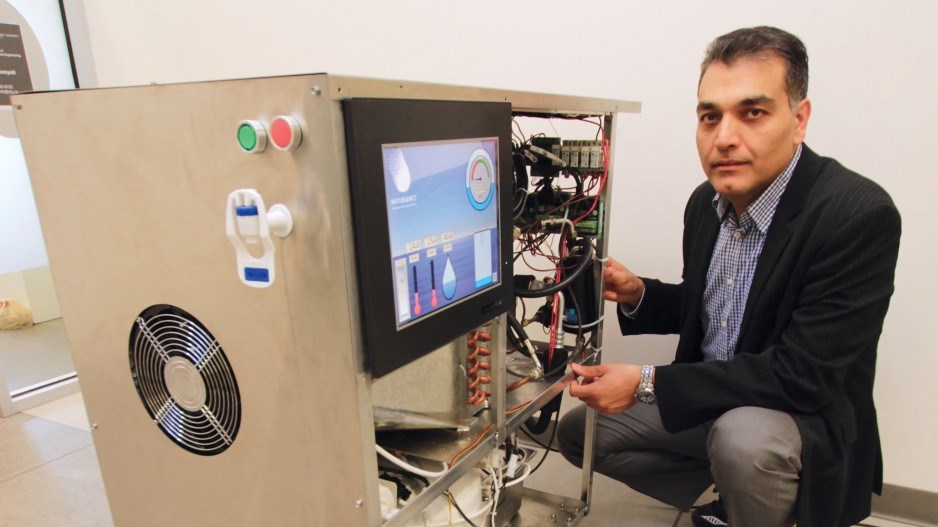Simon Fraser University (SFU) professor Majid Bahrami invented a machine that turns atmosphere into water. Now comes the hard part: getting it to the people who need it most.
Bahrami’s Hybrid Atmospheric Water Generator (HAWgen), which is about the size of an air conditioner, absorbs moisture from the air, then condenses and filters it in a refrigeration unit.
Bahrami’s machine, which he spent the past three years working on with PhD student Farshid Bagheri, can operate in a warm, dry climate and can run on waste heat or through renewable energy sources.
“Our device enables you to extract water anywhere on the planet, regardless if you have water or not,” said Bahrami. “If you’re in the middle of the desert, no water is available, you can get it.”
The machine is already racking up awards and nominations including a 2016 Canada Clean50 Award and a BC Technology Industry Association 2016 Technology Impact Award.
Developed in Bahrami’s Surrey-based SFU Laboratory for Alternative Energy Conversion, the technology will be marketed through the company Bahrami founded, Watergenics Inc.
Uwe Glässer, dean of SFU’s faculty of applied sciences, said Bahrami is an example of the cutting edge of sustainability research.
“Majid has earned more than $10 million from funding agencies for his alternative energy research,” he said.
Bahrami said now he needs to use that capital properly as the company enters the next phase.
“I appreciate the difference between an academic and scientific breakthrough and an actual industrial product,” said Bahrami. “And there is a gap. We need to build products that people can buy and install. It has to do with manufacturing, distribution, marketing, fundraising. So there is a big gap, and we need to now go through this valley to make it out to the market.”
Bahrami hopes to engage both the public and private sectors in rolling out HAWgen.
He knows it’s more complicated than simply putting the device on store shelves or trucking it into drought-stricken countries.
Bahrami said he hopes to lean on experts in the field of commercialization and distribution.
U.S. scientist Dean Kamen, who created the Segway, also invented a water-purification device called Slingshot, which has run into multiple hurdles in its rollout.
When testing the machine in developing nations, Kamen found locals brought contaminated cups and bowls to fill up from Slingshot, which negated its effects.
In other areas, the device was either stolen or commandeered by locals.
“I don’t want to give the impression that we are not looking into this, the business side, the profits,” said Bahrami. “And there are people who will invest and want their money back with interest. But I’m sure there will be opportunities; there are lots of NGOs that will be interested in this.”
Tanja McQueen, chief executive officer of the BC Water & Waste Association, said HAWgen is a remarkable invention that has the potential to help solve the world’s water crisis, but she acknowledges that an invention is sometimes a far cry from a commercial-ready product.
“Every water technology out there has been challenged with the same issue, and that’s technology adoption,” McQueen said. “And how do you convince the buyer that your technology is going to be safe? So that’s issue No. 1. I don’t think it’s an insurmountable issue, but it’s going to be one that they’re going to have to address when they go to market.”
McQueen, who used to work for an industrial water treatment technology company that catered chiefly to the mining industry, said Bahrami’s device is promising, but financial hurdles now need to be cleared.
“I’ve seen lots of technology where the technology itself is great. But … is there a value proposition there for the customer?”




